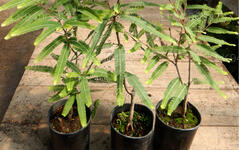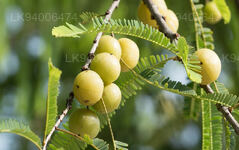
Ayurvedic Medicinal Plants of Sri Lanka
Sri Lanka's Ayurvedic tradition features a rich variety of medicinal plants used for centuries. Sri Lanka has a rich tradition of Ayurvedic medicine, drawing on its indigenous knowledge and a variety of medicinal plants. Here are some notable Ayurvedic medicinal plants found in Sri Lanka:
Phyllanthus emblica; බෙහෙත් නෙල්ලි
The tree is small to medium in size, reaching 1–8 m (3 ft 3 in – 26 ft 3 in) in height. The branchlets are not glabrous or finely pubescent, 10–20 cm (3.9–7.9 in) long, usually deciduous; the leaves are simple, subsessile and closely set along branchlets, light green, resembling pinnate leaves. The flowers are greenish-yellow. The fruit is nearly spherical, light greenish-yellow, quite smooth and hard on appearance, with six vertical stripes or furrows.
Ripening in autumn, the berries are harvested by hand after climbing to upper branches bearing the fruits. The taste of Indian emblic is sour, bitter and astringent, and it is quite fibrous.
In the Buddhist tradition, half an amalaka fruit was the final gift to the Buddhist sangha by the great Indian emperor Ashoka. This is illustrated in the Ashokavadana in the following verses: "A great donor, the lord of men, the eminent Maurya Ashoka, has gone from being lord of Jambudvipa [the continent] to being lord of half a myrobalan" (Strong, 1983, p. 99).[5] In Theravada Buddhism, this plant is said to have been used as the tree for achieving enlightenment, or Bodhi, by the twenty first Buddha, named Phussa Buddha.
The amla fruit is eaten raw or cooked into various dishes, such as dal (a lentil preparation) and amle ka murabbah, a sweet dish made by soaking the berries in sugar syrup until they are candied. It is traditionally consumed after meals.
Indian gooseberry pickle In the Batak area of Sumatra, Indonesia, the inner bark is used to impart an astringent, bitter taste to the broth of a traditional fish soup known as holat
Phyllanthus emblica is part of the catalog of ayurvedic medicinal plants of Sri Lanka.
-

Ankenda
Acronychia pedunculata -

Beli
Aegle marmelos -

Bakmi
Nauclea orientalis -

Bangwel-geta
Coscinium fenestratum -

Bukinda /Walkinda
Tinospora malabarica -

Bu- kobbe
Allophylus cobbe -

Dodan –kaha
Memecylon capitellatum -

Diyamitta
Cissampelos pareira -

Embul dodan
Citrus aurantium -

Gas nidikumba
Biophytun reinward -

Hintambala
Carmona microphylla -

Goraka
Garcinia cambogia -

Karapincha
Murraya koenigii -

Keppetiya
Croton laccifer -

Kohomba
Azadirachta indica -

Kotikan-bevila
Sida alba -

Kudumiris (Forest paper)
Toddlia asiatica -

Kurundu
Cinnamomum zeylanicum -

Mahakaramba
Carissa carandas -

Muna mal
Mimusops elengi -

Nelli
Phyltanthus emblica -

Puwak
Areca catechu -

Rath mal
Ixora coccinea -

Eepatta / Ruk - anguna
Alangium salviifolium -

Siyambala
Tamarindus indica -

Walangasal / Wal-embilla
Embelia ribes -

Wal Karapincha
Micromelum ceylanicum -

Welangiriya
Paramignya monophylla

Medicinal Plants of Sri Lanka by Nandana Gunaratne and Jayamali Gunarathna
Download
Medicinal Plants (Indigenous and Exotic) Used in Ceylon by Jayaweera
DownloadAyurvedic and Herbal
-
Lakpura Wildcrafted Soursop (Guanabana, Graviola, Guyabano) Dehydrated Leaves Whole
Redna cena Od €1,95 EURRedna cenaCena na enoto / na -
Siddhalepa Ayurveda Herbal Balm
Redna cena Od €0,95 EURRedna cenaCena na enoto / na -
Sethsuwa Pranajeewa Oil
Redna cena Od €3,95 EURRedna cenaCena na enoto / na -
MeGha Primal Intake (15 Caps)
Redna cena €19,95 EURRedna cenaCena na enoto / na















































